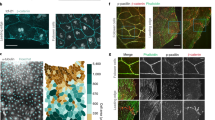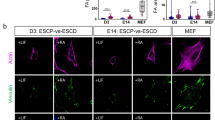Abstract
Understanding the factors that direct tissue organization during development is one of the most fundamental goals in developmental biology. Various hypotheses explain cell sorting and tissue organization on the basis of the adhesive and mechanical properties of the constituent cells1. However, validating these hypotheses has been difficult due to the lack of appropriate tools to measure these parameters. Here we use atomic force microscopy (AFM) to quantify the adhesive and mechanical properties of individual ectoderm, mesoderm and endoderm progenitor cells from gastrulating zebrafish embryos. Combining these data with tissue self-assembly in vitro and the sorting behaviour of progenitors in vivo, we have shown that differential actomyosin-dependent cell-cortex tension, regulated by Nodal/TGFβ-signalling (transforming growth factor β), constitutes a key factor that directs progenitor-cell sorting. These results demonstrate a previously unrecognized role for Nodal-controlled cell-cortex tension in germ-layer organization during gastrulation.
This is a preview of subscription content, access via your institution
Access options
Subscribe to this journal
Receive 12 print issues and online access
$209.00 per year
only $17.42 per issue
Buy this article
- Purchase on Springer Link
- Instant access to full article PDF
Prices may be subject to local taxes which are calculated during checkout





Similar content being viewed by others
References
Tepass, U., Godt, D. & Winklbauer, R. Cell sorting in animal development: Signalling and adhesive mechanisms in the formation of tissue boundaries. Curr. Opin. Genet. Dev. 12, 572–582 (2002).
Montero, J. A. & Heisenberg, C. P. Gastrulation dynamics: Cells move into focus. Trends Cell Biol. 14, 620–627 (2004).
Brodland, G. W. The differential interfacial tension hypothesis (dith): a comprehensive theory for the self-rearrangement of embryonic cells and tissues. J. Biomech. Eng. 124, 188–197 (2002).
Benoit, M., Gabriel, D., Gerisch, G. & Gaub, H. E. Discrete interactions in cell adhesion measured by single-molecule force spectroscopy. Nature Cell Biol. 2, 313–317 (2000).
Puech, P. H., Poole, K., Knebel, D. & Muller, D. J. A new technical approach to quantify cell-cell adhesion forces by afm. Ultramicroscopy 106, 637–644 (2006).
Zhang, X. et al. Atomic force microscopy measurement of leukocyte-endothelial interaction. Am. J. Physiol. Heart Circ. Physiol. 286, H359–367 (2004).
Gumbiner, B. M. Regulation of cadherin-mediated adhesion in morphogenesis. Nature Rev. Mol. Cell Biol. 6, 622–634 (2005).
Ulrich, F. et al. Wnt11 functions in gastrulation by controlling cell cohesion through Rab5c and E-cadherin. Dev. Cell 9, 555–564 (2005).
Montero, J. A. et al. Shield formation at the onset of zebrafish gastrulation. Development 132, 1187–1198 (2005).
Geiger, B. et al. Broad spectrum pan-cadherin antibodies, reactive with the C-terminal 24 amino acid residues of N-cadherin. J. Cell Sci. 97, 607–614. (1990).
Harris, A. K. Is cell sorting caused by differences in the work of intercellular adhesion? A critique of the steinberg hypothesis. J. Theor. Biol. 61, 267–285 (1976).
Dai, J., Ting-Beall, H. P., Hochmuth, R. M., Sheetz, M. P. & Titus, M. A. Myosin I contributes to the generation of resting cortical tension. Biophys. J. 77, 1168–1176 (1999).
Evans, E. & Yeung, A. Apparent viscosity and cortical tension of blood granulocytes determined by micropipet aspiration. Biophys. J. 56, 151–160 (1989).
Thoumine, O., Cardoso, O. & Meister, J. J. Changes in the mechanical properties of fibroblasts during spreading: A micromanipulation study. Eur. Biophys. J. 28, 222–234 (1999).
Schier, A. F. Nodal signaling in vertebrate development. Annu. Rev. Cell Dev. Biol. 19, 589–621. (2003).
Gritsman, K. et al. The EGF–CFC protein one-eyed pinhead is essential for nodal signaling. Cell 97, 121–132 (1999).
Schötz, E.-M. et al. Quantitative differences in tissue surface tension influence zebrafish germ layer positioning HFSP J. 2, 42–56 (2008).
Davis, G. S., Phillips, H. M. & Steinberg, M. S. Germ-layer surface tensions and “tissue affinities” in Rana pipiens gastrulae: quantitative measurements. Dev. Biol. 192, 630–644 (1997).
Marlow, F., Topczewski, J., Sepich, D. & Solnica-Krezel, L. Zebrafish Rho kinase 2 acts downstream of Wnt11 to mediate cell polarity and effective convergence and extension movements. Curr. Biol. 12, 876–884 (2002).
Maree, A. F. M., Grieneisen, V. A. & Hogeweg, P. The Cellular Potts Model and biophysical properties of cells, tissues and morphogenesis. in Single Cell-Based Models in Biology and Medicine (eds Anderson, A. R. A., Chaplain, M. & Rejniak, K. A.) 107–136 (Birkhäuser Verlag, Basel; 2007).
Ouchi, N. B., Glazier, J. A., Rieu, J.-P., Upadhyaya, A. & Sawada, Y. Improving the realism of the cellular potts model in simulations of biological cells. Physica A: Stat. Mech. Applic. 329, 451–458 (2003).
Graner, F. Can surface adhesion drive cell-rearrangement? Part I: Biological cell-sorting. J. Theoret. Biol. 164, 455–476 (1993).
Kafer, J., Hayashi, T., Maree, A. F. M., Carthew, R. W. & Graner, F. Cell adhesion and cortex contractility determine cell patterning in the Drosophila retina. Proc. Natl Acad. Sci. USA 104, 18549–18554 (2007).
Shimizu, T. et al. E-cadherin is required for gastrulation cell movements in zebrafish. Mech. Dev. 122, 747–763 (2005).
Warga, R. M. & Kane, D. A. A role for N-cadherin in mesodermal morphogenesis during gastrulation. Dev. Biol. 310, 211–225 (2007).
Steinberg, M. S. Differential adhesion in morphogenesis: A modern view. Curr. Opin. Genet. Dev. 17, 281–286 (2007).
Lecuit, T. & Lenne, P. F. Cell surface mechanics and the control of cell shape, tissue patterns and morphogenesis. Nature Rev. Mol. Cell Biol. 8, 633–644 (2007).
Aoki, T. O. et al. Molecular integration of casanova in the nodal signalling pathway controlling endoderm formation. Development 129, 275–286 (2002).
Carmany-Rampey, A. & Schier, A. F. Single-cell internalization during zebrafish gastrulation. Curr. Biol. 11, 1261–1265 (2001).
Dimitriadis, E. K., Horkay, F., Maresca, J., Kachar, B. & Chadwick, R. S. Determination of elastic moduli of thin layers of soft material using the atomic force microscope. Biophys. J. 82, 2798–2810 (2002).
Rosenbluth, M. J., Lam, W. A. & Fletcher, D. A. Force microscopy of nonadherent cells: A comparison of leukemia cell deformability. Biophys. J. 90, 2994–3003 (2006).
Lomakina, E. B., Spillmann, C. M., King, M. R. & Waugh, R. E. Rheological analysis and measurement of neutrophil indentation. Biophys. J. 87, 4246–4258 (2004).
Crick, S. L. & Yin, F. C. Assessing micromechanical properties of cells with atomic force microscopy: Importance of the contact point. Biomech. Model. Mechanobiol. 6, 199–210 (2007).
Acknowledgements
We thank Pierre Bongrand, Wayne Brodland, Jonne Helenius, Mathias Köppen, Andy Oates, Ewa Paluch, Laurel Rohde, Erik Schäffer, Clemens Franz, Sylvia Schneider, Petra Stockinger, Anna Taubenberger, Florian Ulrich and Simon Wilkins for fruitful discussions; Stan Marée for sharing the simulation code for the Cellular-Potts-Model; Lara Carvalho for sharing unpublished results; JPK Instruments for technical support; Jonne Helenius for supporting data analysis procedures and the fifth floor seminar club for vibrant discussions. This work was supported by grants from the Boehringer Ingelheim Fonds to M. K., Deutsch-Französische Hochschule to M. K. and P. H. P. and the Deutsche Forschungsgemeinschaft to C. P. H.
Author information
Authors and Affiliations
Contributions
M. K. performed and analysed the AFM and biochemical experiments and the hanging drop cell aggregation/sorting experiments; Y. A. performed the molecular biology experiments, embryo injections, cell culture work (sorting and explant analysis), cell transplantations and in situ hybridizations; J. K. performed the simulation experiments and contributed to image analysis; C. P. H., D. M., F. G. and P. H. P. conceived and designed the experiments; M. K., C. P. H., D. M. and P. H. P. prepared the manuscript.
Corresponding authors
Supplementary information
Supplementary Information
Supplementary Figures S1, S2, S3, S4, S5 and Supplementary Table 1 (PDF 910 kb)
Rights and permissions
About this article
Cite this article
Krieg, M., Arboleda-Estudillo, Y., Puech, PH. et al. Tensile forces govern germ-layer organization in zebrafish. Nat Cell Biol 10, 429–436 (2008). https://doi.org/10.1038/ncb1705
Received:
Accepted:
Published:
Issue Date:
DOI: https://doi.org/10.1038/ncb1705
This article is cited by
-
The nuclear lamina couples mechanical forces to cell fate in the preimplantation embryo via actin organization
Nature Communications (2023)
-
Programming multicellular assembly with synthetic cell adhesion molecules
Nature (2023)
-
Entropic repulsion of cholesterol-containing layers counteracts bioadhesion
Nature (2023)
-
Epithelial and stromal co-evolution and complicity in pancreatic cancer
Nature Reviews Cancer (2023)
-
3D cell segregation geometry and dynamics are governed by tissue surface tension regulation
Communications Biology (2023)



